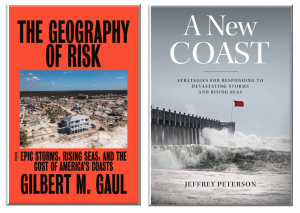2 New Books About Coastal Problems and Solutions
Coastal areas everywhere are being damaged at an accelerating pace. Causes range from erosion, to worsening storms, increased “blue sky flooding” during king tides, and rising sea level . Our history of building ever closer to the shoreline, with densely packed homes has added to the problem. Recently I read two books that shed real insight into the coastal crisis, from slightly different, yet complementary perspectives.
- The Geography of Risk: Epic Storms, Rising Seas, and the Cost of America’s Coasts by Gilbert M. Gaul (Sarah Crichton Books, 2019) is the amazing story of coastal development looking back over the many decades to the warnings, disasters, greed, and hubris. He shows the noble attempts for leadership, often knocked down by short-sighted self-interest. Pulitzer prize winning author Gil Gaul weaves a lot of information into a very readable style, profiling and naming the developers and civic leaders in various coastal communities. He takes us into the town meetings and the political machinations that led to the massive building in harm’s way with the ultimate bill often being paid by the American taxpayer. It makes for a good tragic-comedy, but is public policy at its worst. Though mostly focused on New Jersey, the author’s home, variations of the same tale could apply to most of the two dozen coastal American states.
- A New Coast: Strategies for Responding to Devastating Storms and Rising Seas by Jeffrey Peterson (Island Press, 2019) directly complements Gaul’s book. With decades of experience working at the EPA, the White House, and the Senate, Peterson knows the regulations extremely well. He paints a big picture of the worsening coastal disaster as background. Describing how and why the current policies exist, he then builds a strong case for a bold, new approach, tackling difficult topics including: how to revise flood insurance and disaster assistance programs; when to step back from the coast rather than build protection structures; how to steer new development away from at-risk areas; and even suggests how to finance the transition to a new coast. Key challenges, including how to protect critical infrastructure, ecosystems, and disadvantaged populations, are examined. Ultimately, Peterson offers hope in the form of a framework of new national policies and programs to support local and state governments. He calls for engagement from the private sector and local and national leaders in a “campaign for a new coast.” This book is especially important for policy makers – those in government at all levels who must guide our changing relationship with the shoreline.

